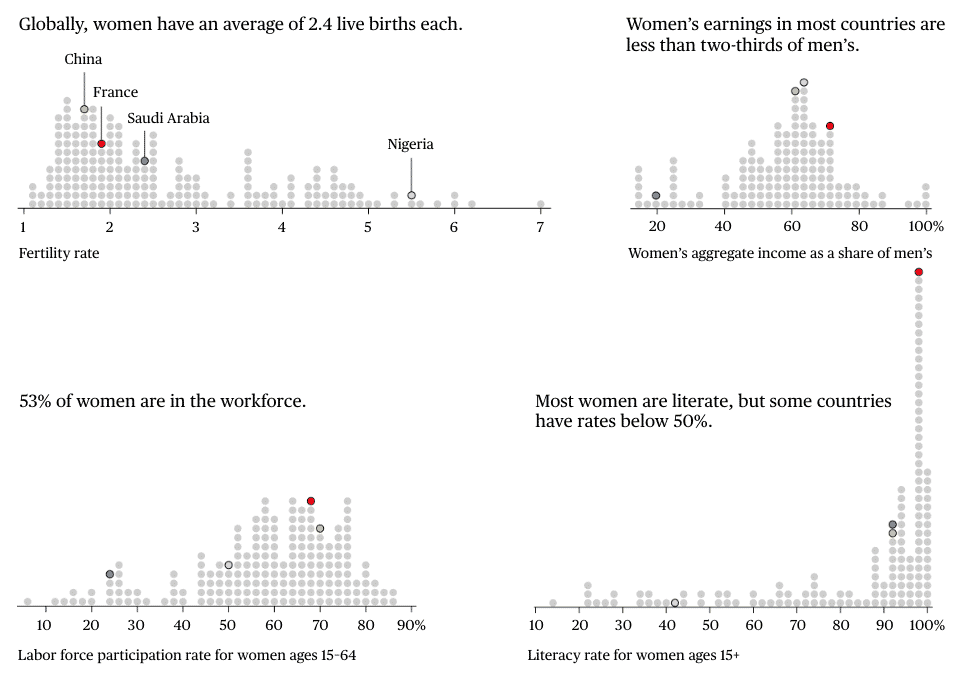
Sustainable Fail: The Global Fertility Crash
 YouTube
YouTubeContrary to UN and globalist propaganda, global populating is crashing, not exploding. The birthrate in many countries is so low that they will cease to exist as discrete nations. For many, the trend is already irreversible. Declining population guarantees huge reductions in economic activity, productivity and economic security. Inflation will turn to deflation, and wars will be fought over precious resources. ⁃ TN Editor
********
ANDRE TARTAR et al.
At least two children per woman—that’s what’s needed to ensure a stable population from generation to generation. In the 1960s, the fertility rate was five live births per woman. By 2017 it had fallen to 2.43, close to that critical threshold.
Population growth is vital for the world economy. It means more workers to build homes and produce goods, more consumers to buy things and spark innovation, and more citizens to pay taxes and attract trade. While the world is expected to add more than 3 billion people by 2100, according to the United Nations, that’ll likely be the high point. Falling fertility rates and aging populations will mean serious challenges that will be felt more acutely in some places than others.
While the global average fertility rate was still above the rate of replacement—technically 2.1 children per woman—in 2017, about half of all countries had already fallen below it, up from 1 in 20 just half a century ago. For places such as the U.S. and parts of Western Europe, which historically are attractive to migrants, loosening immigration policies could make up for low birthrates. In other places, more drastic policy interventions may be called for. Most of the available options place a high burden on women, who’ll be relied upon not only to bear children but also to help fill widening gaps in the workforce.
Each of the following indicators tells a part of the global fertility story: not just how many babies women have on average, but also how well women are integrated into the workforce, what slice of the income pie they receive, and their level of educational attainment. Overall:

Government attempts to manage population growth are nothing new—consider the generous paid maternal leave of the Scandinavian countries or China’s recently rescinded one-child policy, each relatively effective in achieving its stated goal—but a new sense of urgency and even desperation is creeping into the search for ways to reverse the current trends. That said, achieving robust population growth is by no means the only contributor to economic growth—in some countries too-high fertility may actually be a drag on GDP, because of higher costs. But as these indicators suggest, it can be an important tailwind.
To explore these demographic and economic shifts, Bloomberg analyzed fertility data for 200 countries and picked four that were outliers in some respect. Local reporters then interviewed one woman in each place about her economic and cultural forces that shaped her choice to have children—or not.
ER: we left in the final paragraph of the Bloomberg article –
Ultimately, no country will be left untouched by demographic decline. Governments will have to think creatively about ways to manage population, whether through state-sponsored benefits or family-planning edicts or discrimination protections, or else find their own path to sustainable economic growth with ever fewer native-born workers, consumers, and entrepreneurs.

••••
The Liberty Beacon Project is now expanding at a near exponential rate, and for this we are grateful and excited! But we must also be practical. For 7 years we have not asked for any donations, and have built this project with our own funds as we grew. We are now experiencing ever increasing growing pains due to the large number of websites and projects we represent. So we have just installed donation buttons on our websites and ask that you consider this when you visit them. Nothing is too small. We thank you for all your support and your considerations … (TLB)
••••
Comment Policy: As a privately owned web site, we reserve the right to remove comments that contain spam, advertising, vulgarity, threats of violence, racism, or personal/abusive attacks on other users. This also applies to trolling, the use of more than one alias, or just intentional mischief. Enforcement of this policy is at the discretion of this websites administrators. Repeat offenders may be blocked or permanently banned without prior warning.
••••
Disclaimer: TLB websites contain copyrighted material the use of which has not always been specifically authorized by the copyright owner. We are making such material available to our readers under the provisions of “fair use” in an effort to advance a better understanding of political, health, economic and social issues. The material on this site is distributed without profit to those who have expressed a prior interest in receiving it for research and educational purposes. If you wish to use copyrighted material for purposes other than “fair use” you must request permission from the copyright owner.
••••
Disclaimer: The information and opinions shared are for informational purposes only including, but not limited to, text, graphics, images and other material are not intended as medical advice or instruction. Nothing mentioned is intended to be a substitute for professional medical advice, diagnosis or treatment.




